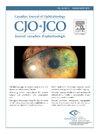Comparing the efficacy and safety between femtosecond laser-assisted cataract surgery and conventional phacoemulsification cataract surgery: systematic review and meta-analysis
IF 3.3
4区 医学
Q1 OPHTHALMOLOGY
Canadian journal of ophthalmology. Journal canadien d'ophtalmologie
Pub Date : 2025-02-01
DOI:10.1016/j.jcjo.2024.05.030
引用次数: 0
Abstract
Objectif
Comparer l'efficacité et l'innocuité de 2 types de chirurgie de la cataracte : la chirurgie de la cataracte au laser femtoseconde (CCLF) et la phacoémulsification conventionnelle (PC).
Méthodes
On a procédé à une recherche systématique des bases de données PubMed, Embase, Cochrane Library, ClinicalTrials.gov, CNKI et Wanfang afin d'en extraire les études comparatives randomisées (ECR). Les principaux paramètres de mesure reposaient sur l'acuité visuelle, les détails relatifs à la capsulotomie, la position effective de l'implant (PEI) et les complications. Les résultats réfractifs de même que les caractéristiques peropératoires et cornéennes comptaient au nombre des paramètres secondaires.
Résultats
Au total, 41 ECR réunissant 9310 yeux ont été retenues. On a noté une différence statistiquement significative en faveur de la CCLF – comparativement à la PC – pour ce qui est de l'acuité visuelle non corrigée de loin à 12 mois (différence moyenne [DM] : –0,03; intervalle de confiance [IC] à 95 % : –0,05 à –0,01), de l'acuité visuelle corrigée de loin à 1 semaine (DM : –0,05; IC à 95 % : –0,07 à –0,02) et à 12 mois (DM : –0,02; IC à 95 % : –0,04 à –0,00), de l'aire de la capsulotomie à 1 mois (DM : 4,04 mm2; IC à 95 % : 3,45–4,64) et à 6 mois (DM : 5,02 mm2; IC à 95 % : 3,28–6,77) et de la distance du centre de l'implant par rapport au centre pupillaire à 1 semaine (DM : –0,06 mm; IC à 95 % : –0,08 à –0,05), à 1 mois (DM : –0,07 mm; IC à 95 % : –0,09 à –0,06) et à 6 mois (DM : –0,06 mm; IC à 95 % : –0,07 à –0,04). Au chapitre des complications chirurgicales, la CCLF a eu une incidence moindre de décentrement de la lentille intraoculaire, comparativement à la PC (rapport de cotes: 0,06; IC à 95 % : 0,01–0,24). Enfin, la CCLF n'a pas augmenté l'incidence d'autres complications per- ou postopératoires, à l'exception de l'hémorragie sous-conjonctivale.
Conclusions
La CCLF et la PC sont toutes deux sûres et efficaces. La CCLF produit de meilleurs résultats visuels tôt après la chirurgie et pendant le suivi à long terme, sans compter qu'elle a donné lieu à une capsulotomie plus précise et à une meilleure PEI que la PC. Cela dit, aucune différence n'a pu être notée au chapitre des résultats visuels après un suivi de durée intermédiaire.
飞秒激光辅助白内障手术与传统超声乳化白内障手术的疗效和安全性比较:系统综述和荟萃分析。
目的研究飞秒激光辅助白内障手术(FLACS)与传统超声乳化白内障手术(CPCS)相比的有效性和安全性:在PubMed、Embase、Cochrane Library、ClinicalTrials.gov、CNKI和万方数据库中系统检索了随机对照试验(RCT)。主要结果包括视力、囊切参数、有效晶状体位置和并发症。次要结果包括屈光结果、术中参数和角膜参数:结果:共纳入了 41 项 RCT,涉及 9310 只眼睛。在 12 个月的未矫正远距离视力(平均差 [MD] -0.03;95% CI -0.05至-0.01)、1 周的矫正远距离视力(MD -0.05;95% CI -0.07至-0.02)和 12 个月的矫正远距离视力(MD -0.02;95% CI -0.04至-0.00)、囊膜面积(MD -0.05;95% CI -0.07至-0.02)、角膜曲率(MD -0.01)、角膜曲率(MD -0.01)和角膜曲率(MD -0.01)方面,FLACS优于CPCS,差异有统计学意义。00);1个月(MD为4.04平方毫米;95% CI为3.45-4.64)和6个月(MD为5.02平方毫米;95% CI为3.28-6.77)的囊切面积;1周(MD为-0.06毫米;95% CI为-0.08--0.05)、1个月(MD为-0.07毫米;95% CI为-0.09--0.06)和6个月(MD为-0.06毫米;95% CI为-0.07--0.04)的眼内晶状体中心点-瞳孔中心点距离。在手术并发症方面,FLACS的人工晶体脱落发生率低于CPCS(几率比0.06;95% CI 0.01-0.24)。然而,除结膜下出血外,FLACS 并未增加其他术中或术后并发症的发生率:结论:FLACS 和 CPCS 均有效且安全。结论:FLACS 和 CPCS 都是有效和安全的,FLACS 在术后早期和长期随访中获得了更好的视觉效果,同时,与 CPCS 相比,FLACS 的囊袋切除更准确,有效晶状体位置更优化。然而,中期随访后发现两者的视觉效果并无差异。
本文章由计算机程序翻译,如有差异,请以英文原文为准。
求助全文
约1分钟内获得全文
求助全文
来源期刊
CiteScore
3.20
自引率
4.80%
发文量
223
审稿时长
38 days
期刊介绍:
Official journal of the Canadian Ophthalmological Society.
The Canadian Journal of Ophthalmology (CJO) is the official journal of the Canadian Ophthalmological Society and is committed to timely publication of original, peer-reviewed ophthalmology and vision science articles.

 求助内容:
求助内容: 应助结果提醒方式:
应助结果提醒方式:


